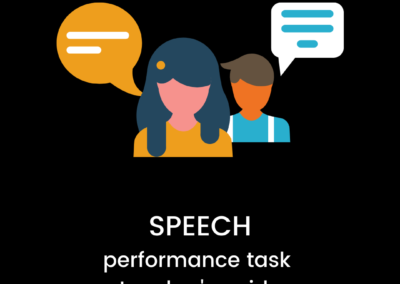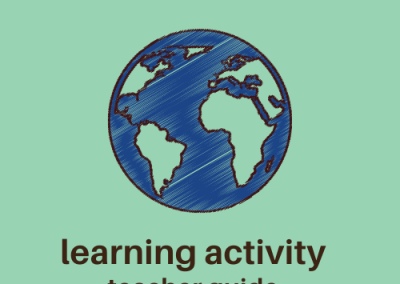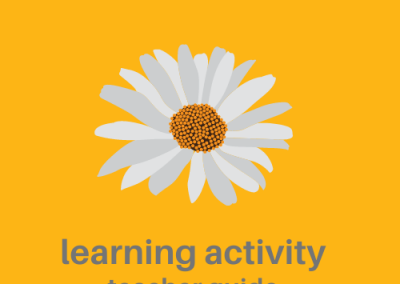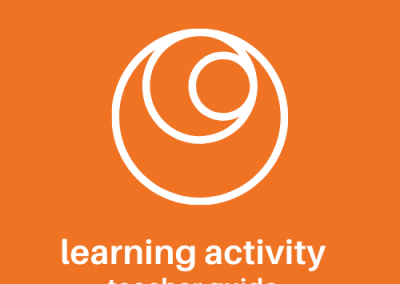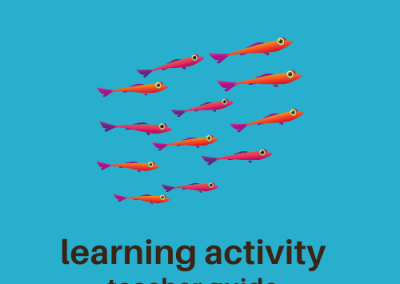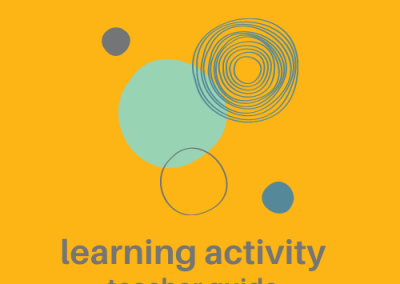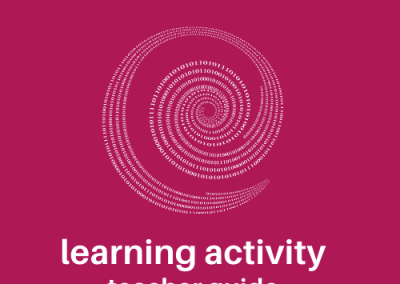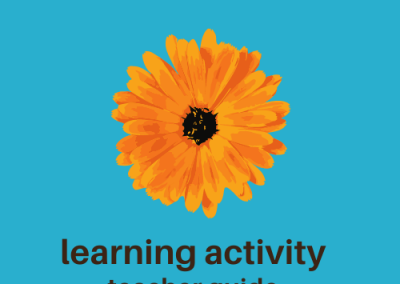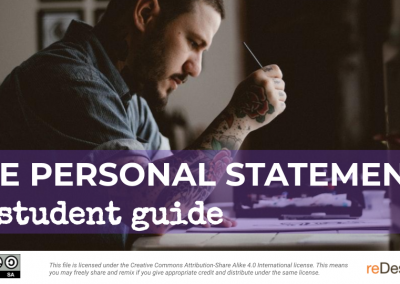Setting Graphic Organizer
This students help students to recognize the key features of a text’s setting, and to understand how the setting of a text contributes to its meaning. As they read, they complete a graphic organizer that directs their attention to important aspects of the setting, and then asks them to think about each aspect of the setting is important.
Preparation
- Identify the text or portion of a text that you want students to read. You should select something that has a clear and well-elaborated setting. It can be effective to select something in which the setting contributes significantly to the meaning of the story.
- Create a graphic organizer labeled “Setting,” with two sides. The Time side should contain boxes with the following labels: “Time(s) in history” “Season(s)” and “Time(s) of the day” “Senses,” “Associations,” and “Moods/Feelings.” The Place side should contain boxes with the following labels: “Where in the world,” “Where locally,” “Spaces,” “Senses,” “Associations,” and “Moods/Feelings.”
.
Activity Steps
1
Teacher briefly reviews the concept of setting: where and when a story takes place. Teacher displays a model completed graphic organizer based on a familiar and easy text, and clarifies what belongs in each box.
Prepare to display the model graphic organizer while students work. You may want to fill it out based on a very simple and familiar story, such as a fairy tale.
2
Teacher displays a short text on a slide or projector. Teacher models reading aloud from the text, identifying/highlighting textual cues, and completing each box in the graphic organizer.
You will want to model the iterative process of reading back through the text multiple times, each times looking for a different set of clues. Think aloud about how each identified clue gives you the information, and think aloud about the inferences you are making.
If this is a new activity, you may want students to focus on just a subset of the graphic organizer each day, until eventually they work up to completing the whole thing.
3
Teacher distributes blank graphic organizers. Alone or in pairs, students prepare to read the text.
You may want to ask students to read the text once before attempting to fill in the graphic organizer.
4
Students complete the graphic organizer as they read.
Circulate as students are working and ask them about what they are noticing and thinking.
Encourage students to work through the graphic organizer in an order that makes sense to them.
5
Students identify when in historical the story takes place, and describe this in the “When in history” section.
Help students to identify clues in the text that help them find this information.
Sometimes students will have particular year(s), other times they will need to use clues to narrow down the time to a general period.
6
Students identify the season(s) in which the story takes place, and describes this in the “Seasons” box.
Circulate, asking students to explain their thinking and help them to identify clues.
7
Students identify the time(s) in the day when the story takes place, and describes this in the “time(s) of day” box.
While some stories take place at various times of day, others are much more localized at a particular time of day. Help students to look for clues in the text.
8
Students think about the sensory information associated with the time of the setting. They describe this in the “Senses” box on the Time side of the graphic organizer.
For example, fall in New England is associated with the smell of fallen leaves, crisp dry air, bright sunlight, the feeling of frozen ground, etc. Different times evoke different sensory responses.
9
Students think about the memories, connotations, or associations related to the time(s) of the story. They record their ideas in the “Associations” box on the Time side of the graphic organizer.
This is tricky for many students, but is important, since associations and connotation contribute to meaning. Help students to think about the ideas that are associated with the time of the story. For example, a story set in the evening might be associated with loss, or death, or waning time. A story set in Nazi Germany would be associated with ideas like war, genocide, propaganda, and eugenics. Consider bringing up examples like the novel Now in November, whose plot centers on an impending ending. Some texts might have really different associations of time/place, and the dissonance of the associations might be critical to understanding meaning. For example, in Michener’s Tales of the South Pacific there’s a lot of meaning in the fact that the place evokes feelings of peace, calm, beauty, and associations with vacations, while the time evokes feelings of fear, grief, displacement, horror, and the association of war and death.
10
Students think about the moods or feelings evoked by the time(s) of the story. They record their ideas in the “mood/feelings” box of the Time side of the organizer.
For example, spring can be associated with feelings of energy and hope, night can be associated with fear or mystery.
11
Students flip over their graphic organizers and return to the text to consider the place(s) of the story. First, they think about the geographical location(s) of the story (continent(s), country/ies), and describe it in the box marked “Where in the world
Some students will get confused if a text is set in an imagined or futuristic world, or if a location is not explicitly mentioned. In these cases, guide students to look for clues, to make inferences, and to describe the place as well as they can.
12
Next, students think about setting on a smaller stage, considering the type of town/city/habitat the story takes place in. Students describe this smaller locale (or locales) in the “Where locally” box on the Place side of their graphic organizers.
You can guide students to consider if the town/city has a name, if it’s urban/suburban/rural, its demographics, its culture, its economy and any other defining characteristics of the locale. Help students to understand that in some texts, the town or locale is as important as a main character, whereas in other texts it’s close to a neutral backdrop.
13
Students think about the smaller stages of the text’s action: the spaces where most of the action takes place. They describe these in the “Spaces” box on the Place side of the organizer.
Here, students should think about the immediate setting(s) of the majority of the scenes. These spaces might be private (like inside of a house, a room, or a car, or in a private yard or field), or public (like a street, or the ocean, or inside a store, school, or courthouse). Students should be encouraged to describe these immediate settings with as much detail as is provided.
14
Students think about where the story takes place, and they think about the senses associated with the place(s). They record their ideas in the “Senses” box of the Place side of the organizer.
A suburban New England backyard in the summer, for example, might be associated with the smell of grilling meet or freshly cut grass, the feel of grass on the feet or sun on the head, and the sound of cicadas or yelling children. An open market in Tanzania might be associated with the feeling of sweaty bodies pressed close together, the smell of raw meat and bulk spices, and the sight of colorful clothes on people’s bodies and spread out for sale.
Encourage students to brainstorm the senses associated with each of the primary locales. If they have no experience with the locales, you might consider letting them do some internet research to get ideas, and you should encourage them to look for clues in the story.
15
Students think the ideas or words associated with the place(s) of the story. They record their ideas in the “Associations” box of the Place side of the organizer.
For example, a setting on the US frontier might be associated with ideas like exploration, the gold rush, and cowboys, with historical figures like Lewis and Clark, and with events like the genocide of Native Americans.
16
Students consider the feelings or mood evoked by the place(s) of the story, and they describe these in the “Mood/Feelings” box of the Place side of the graphic organizer.
For example, a story set in the wilds of Alaska might evoke feelings like excitement, exhilaration, fear, and danger. A story set in the post-war South might evoke feelings like nostalgia and grief, or hope and relief, depending on the characters involved.
17
Students reflect on their learning alone or individually, orally or in writing.
Students should respond to questions including:
- How can setting inform the meaning of a text?
- How can you most effectively analyze the setting of a text?
- How can you tell what aspect(s) of a setting are important for a story?
- When might this activity be most useful to you?
18
Students think the ideas or words associated with the place(s) of the story. They record their ideas in the “Associations” box of the Place side of the organizer.
For example, a setting on the US frontier might be associated with ideas like exploration, the gold rush, and cowboys, with historical figures like Lewis and Clark, and with events like the genocide of Native Americans.

